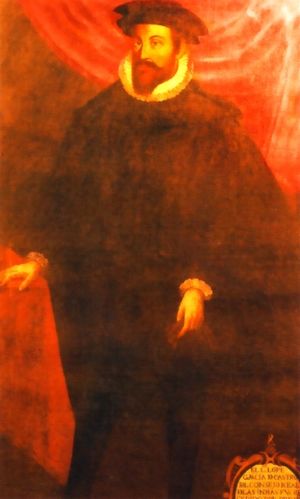Lope García de Castro facts for kids
Quick facts for kids
Lope García de Castro
|
|
|---|---|
 |
|
| Interim Viceroy of Peru | |
| In office September 2, 1564 – November 26, 1569 |
|
| Monarch | Philip II |
| Preceded by | Juan de Saavedra |
| Succeeded by | Francisco de Toledo |
| Personal details | |
| Born | 1516 Villanueva de Valdueza |
| Died | 8 January 1576 Madrid |
Lope García de Castro (born 1516 – died 1576) was an important Spanish leader in the Americas. He was a member of the Council of the Indies, which helped govern Spain's colonies. He also worked in courts called Audiencias in Panama and Lima. From 1564 to 1569, he served as the temporary leader, or interim Viceroy, of Peru.
Contents
Early Life and Career
Lope García de Castro was born in a place called Villanueva de Valdueza in Spain.
In 1563, the Spanish government sent him to Panama. His job was to help organize the government there. He arrived in Panama in 1564 and worked as its governor for a while.
Becoming Viceroy of Peru
In February 1564, the leader of Peru, Viceroy Diego López de Zúñiga y Velasco, died suddenly. The president of the main court in Lima, Juan de Saavedra, became the temporary leader.
Lope García de Castro was then sent from Panama to take over. He became the governor, captain general, and president of the court in Lima. This meant he was effectively the temporary Viceroy of Peru. He arrived in Lima on September 22, 1564. He served in this important role until 1569.
Exploring New Islands
People in Peru had old stories about islands in the Pacific Ocean. These islands were called Hahuachimbi and Ninachumbi. The Spanish heard these stories and called them the Solomon Islands. They thought these islands might be full of gold, like the biblical King Solomon's mines.
Viceroy García de Castro decided to send a group of ships to find these islands. He wrote to King Philip II about his plan. He sent his nephew, Alvaro de Mendaña de Neira, with 100 men on two ships. This expedition discovered Wake Island and the Solomon Islands.
Keeping Order in Peru
García de Castro suspected that the Inca people were planning a rebellion. This was happening in areas that are now Chile and Argentina. After finding some clues, he ordered that all horses and firearms be taken from the local people. This was to prevent any uprising.
In 1567, a group led by Captain Martín Ruiz de Gamboa was sent to take control of Chiloé Island in Chile. Ruiz did not face much resistance. He founded a city there and named it Castro, after Viceroy García de Castro.
Royal Mint in Lima
On August 21, 1565, King Philip created a royal mint in Lima. A mint is a place where coins are made. A previous viceroy had asked for this. However, this mint only operated for a short time.
Later Life
Lope García de Castro died in Madrid, Spain, in 1576.
See also
 In Spanish: Lope García de Castro para niños
In Spanish: Lope García de Castro para niños

